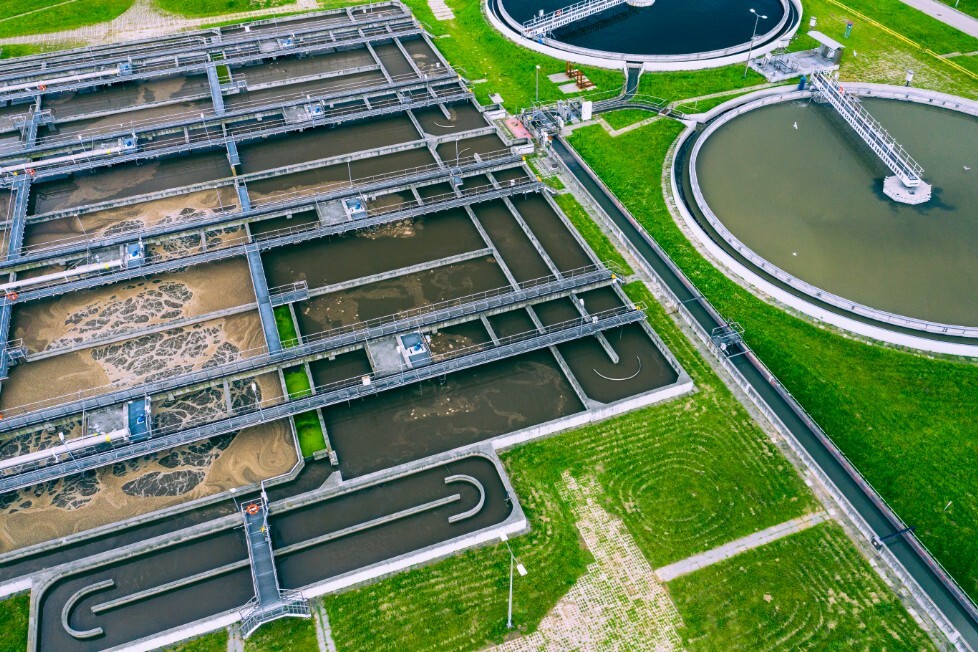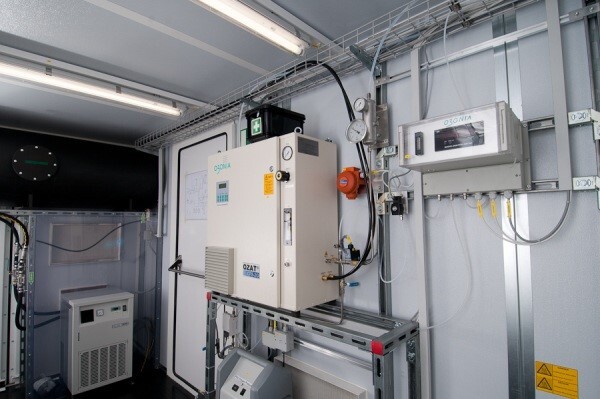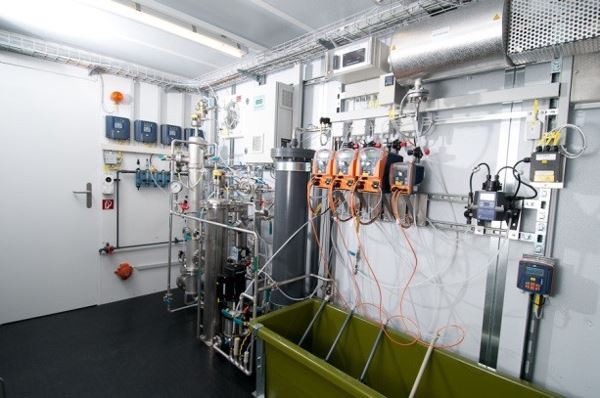AOP experimental plant for the elimination of micropollutants in wastewater treatment plants.
Eliminate micropollutants through wastewater treatment in wastewater treatment plants
Anthropogenic trace substances that are not completely degraded in wastewater treatment plants and enter water bodies are increasingly the focus of public, political and media attention. Once these substances, which occur in low concentrations, are present in the water cycle, they can affect not only surface waters but also other drinking water resources, such as groundwater.
The detection of various micropollutants in the effluent of conventional municipal wastewater treatment can largely be attributed to the increasing consumption of pharmaceuticals, care products, hormones and surfactants. The toxicological effectiveness, for example of endocrine disrupting hormones on aquatic organisms, has now been proven beyond doubt.
In the EU, the Water Framework Directive regulates the required reduction of pollution with hazardous and toxicologically questionable pollutants in surface waters.
So far, micropollutants from pharmaceuticals, personal care products and industrial chemicals are not yet included in the list of priority substances.
Proposals for the respective environmental quality standards are already being actively discussed in the committees.
For example, the painkiller diclofenac is on the so-called “watch list” and may be subject to a limit value of 100 µg/l in the next few years.
Special-purpose associations, cities and municipalities – especially in North Rhine-Westphalia – have taken up the problem and for several years have been using the funding program of the State Ministry of the Environment for feasibility studies and pilot trials for testing the following process technologies:
- Ozonation
- AOP (Advanced Oxidation Process)
- Use of activated carbon

In cooperation with the Swiss company Ozonia, the market leader in industrial ozone technology, we offer studies, pilot testing and plant design for ozone and AOP plant technology for effective wastewater treatment.
Our current activities focus on the rental operation of the 20″ AOP container, which has a fully equipped pilot plant for variable ozonation, UV irradiation and hydrogen peroxide dosing for oxidative wastewater treatment.


The container is equipped with an OZAT® ozone generator and self-sufficient oxygen supply for the generation of max. 50 g/h ozone at up to 12 wt% concentration.
In addition, the plant is equipped with an Aquaray® LPHO UV system with 60 W lamp power.
These two systems are combined with a hydrogen peroxide (H2O2) dosing system and a dosing system for pH value adjustment.
The pilot plant offers the possibility to test five different AOP processes over different reactor systems. The operation and measurement of all important process parameters – dissolved ozone,
UV transmission, H2O2 concentration, redox and pH value – is carried out automatically and is clearly visualized on the plant control system.
All operating data are stored on an industrial PC and can be transferred to data carriers for further documentation.
The COD value can be determined discontinuously by means of an existing COD analysis set at various sampling points. The effect of the oxidation process and the condition of the water quality can thus be continuously monitored during the treatment process.
In the photochemical reactor, water containing ozone and/or hydrogen peroxide is exposed to UV radiation to generate highly reactive hydroxyl radicals.
In the chemical reactor, hydrogen peroxide can be added to the ozone-containing water via various dosing points to ensure an effective yield of hydroxyl radicals.
Ozone and hydroxyl radicals are very strong oxidants, are highly reactive in water and are very effective in eliminating trace substances present down to below the analytical detection limit.
The two reactor units are designed for a water flow rate of 30 – 1200 l/h to be treated.
The supply from a tank available in the container can be regulated automatically.
The ozone dose to be adjusted to the flow rate and the residence time of the water in the reactor is between approx. 0.5 and 1500 mg/l. Hydrogen peroxide dosage is possible from approx. 1 – 5000 mg/l.
The UV irradiation dose depending on UV transmission and flow rate of the water is between approx. 300 and 2000 J/m2.
The contact times for treatment in both reactors can thus be set between approximately 1 and 60 minutes, depending on the process conditions.
The air-conditioned 20″ container is equipped with all safety devices for automatic operation and monitoring of the process conditions. On the operator side, only electrical power and the water to be treated need to be connected.
As part of a current research project, the container was successfully operated for one year by the Institute for Urban Water Management ISA of RWTH Aachen University at the Neuss pilot sewage treatment plant.
The degradation of micropollutants in the wastewater treatment plant effluent was investigated and it was clearly demonstrated that the oxidation processes are ideally suited for the elimination of pharmaceutical residues and industrial chemicals.
Currently, the container plant is being used for the ozonation of effluent water at another municipal wastewater treatment plant in NRW. In the test program, the effect of different ozone doses and contact times on the degradation dynamics of micropollutants is being investigated in particular.
Elimination of micropollutants in the water treatment of wastewater treatment plants
We will be pleased to support you individually with your application, with the design and selection of the equipment technology for your wastewater treatment.
Request individual offer directly online
Request an offer directly via the watch list.
After consultation with you, we will be happy to create your individual offer with these products or products that match your needs.
Our experts will contact you prepared.